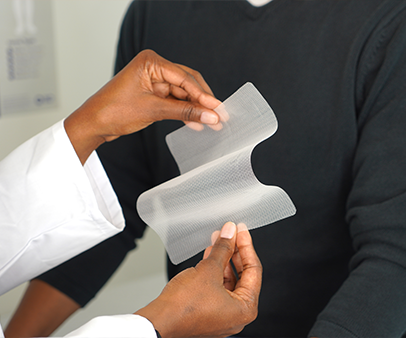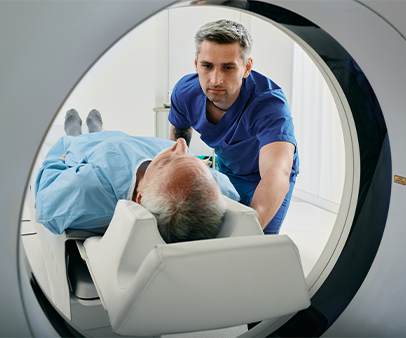While having a hernia may be a new experience for most patients, they are not a new or rare occurrence—they are a very common condition. Over 5 million people in the United States have hernias.1 Learn about some of the technological innovations and methodologies that are advancing hernia prevention and care today.
A Brief History of Hernia Repair2
According to the National Institute of Health, the surgical description and treatment of hernias dates back to ancient Egypt.
- By the 19th century, medical breakthroughs, advances in anesthesia and human anatomical descriptions were aiding surgeons in understanding more about the surgical repair of hernias.
- By the 20th century, further advances were made when synthetic polymers were invented—creating breakthroughs in mesh development and lowered incidences of hernia recurrence.
- By the 21th century, new advances in mesh development and surgical techniques as well as enhanced educational initiatives and surgical treatment options are continuing to help patients anatomically and physiologically while also focusing on a low recurrence rate.
Surgical Treatment Options for Hernia
While roughly 5 million Americans have hernias, only about 700,000 (or 14%) have them surgically repaired.1 However, surgery is required in order to fully repair a hernia as they will not go away on their own and tend to worsen over time.
Today, there are many effective surgical options for treating a hernia. Innovations in minimally invasive surgical techniques can allow for less pain, fewer complications, and shorter postoperative recovery times.3 Laparoscopic repair, which only requires a small incision, is increasingly popular, while a new pathway for robotic hernia repair allows for better visualization and more accurate control over the surgical area.4,5 Either of these options can be combined with surgical mesh. A doctor may opt for a traditional open surgery when minimally invasive techniques are less feasible, such as when a previous surgery has caused scar tissue, or based on the surgeon's training and preference for an open surgical technique.
The appropriate type of surgery for you may depend on the size, severity, and location of your hernia. There are three primary surgical options for hernia repair:
Open Surgery: A traditional surgery where an incision is made at the site of the hernia and mesh is placed between layers of muscle for a durable repair.6 Depending on your surgical history, such as if a previous surgery has caused scar tissue, doctors may opt for this more traditional approach.
Laparoscopic Surgery: A type of minimally invasive surgery that only requires a small ‘keyhole’ incision, laparoscopic repairs use a small camera and specialized minimally invasive tools for accuracy.7 Patients may experience a faster recovery following laparoscopic repair compared to an open surgery.8,9
Robotic Surgery: Similar to laparoscopic repair, a robotic hernia repair is a minimally invasive surgery requiring small incisions where the surgeon controls the procedure from a specialized robotic console.7 Patients may also experience a faster recovery following robotic surgery compared to an open surgery.10
Learn more about Surgical Options.
Hernia Mesh Options
Surgeons often use surgical mesh to strengthen a hernia repair and reduce the rate of recurrence. The use of mesh to repair a hernia may also improve patient outcomes through decreased operative time and minimized recovery time.9 Many factors affect recovery time, however, including the size, shape and type of the hernia, the surgical technique used, and the patient's condition.
In addition to advancements in surgical technologies, innovations in mesh are enabling new pathways for repair techniques as well. For patients seeking an alternative to synthetic mesh, bioresorbable mesh alternatives can work with your body to rebuild your tissue and leave you with a strong repair. A strong repair can reduce the rate of hernia recurrence.
It’s important to know the mesh options you have as a patient. There are three primary mesh options for hernia repair:
- Synthetic Mesh: Synthetic meshes made from plastic materials (e.g., polypropylene, polyester, etc.) are permanent implants used to repair hernias. These non-absorbable meshes remain in the body to provide support to the site of the repair and are considered a more traditional approach.11,12
- Bioabsorbable Mesh: Bioabsorbable (or “resorbable”) mesh is a fully absorbable mesh made of natural biomaterials. The mesh is designed to degrade over time leaving new tissue growth to support the site of the repair.12
- Biological Graft: A biological graft is an implant derived from animal or human tissue. It is most often used in complicated hernia repair procedures. Similar to bioabsorbable mesh, biologic grafts are intended to degrade completely over time to continue supporting the repair even after the graft dissolves.12
Learn more about Mesh Options.
You should discuss these options, and the benefits and risks of each, with your doctor to see what option may be right for you. Be better prepared for your consultation with our Doctor Discussion Guide.
The guidance provided in this article follows general rules that should be discussed with your doctor. This article is for informational and educational purposes only. It does not substitute for medical advice. If in doubt, always consult your doctor.
Related Articles
Join the HerniaInfo.com community! Get notified about our latest articles and updates on all things hernia as they become available.


